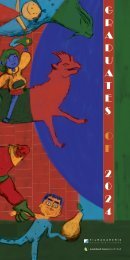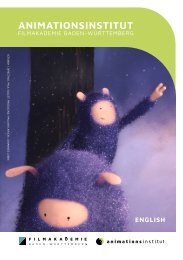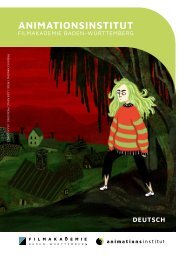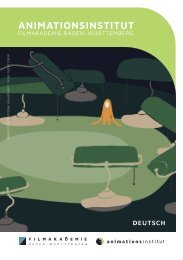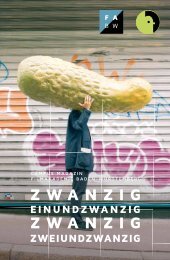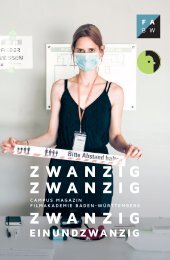Campus Magazin Filmakademie Baden-Württemberg 22/23
Erfolgreiche ePaper selbst erstellen
Machen Sie aus Ihren PDF Publikationen ein blätterbares Flipbook mit unserer einzigartigen Google optimierten e-Paper Software.
tells his story clearly and approachably. He communicates<br />
well and wants to be understood. The film is emotionally<br />
rich, but none of its points are made in an abstract<br />
way. Although taking a very personal point of<br />
view, it even lends itself to be viewed through a political<br />
lens: subtly, it talks about the hardships of working<br />
in the care sector. Not enough time, not enough resources,<br />
and a constant strain on your psyche, which can leave<br />
permanent indentations on your character. More than a<br />
decade later, this message resonates even more strongly<br />
after the Covid pandemic taught us the importance of<br />
such dedicated carers, who are vastly underpaid and often<br />
underappreciated.<br />
The film’s close relationship with reality is also evident<br />
in its formal approach. While being far from photorealism,<br />
the design of the characters is only slightly exaggerated<br />
and simplified. They are puppets that inhabit<br />
an almost naturalistic world. The camera is bound by<br />
the laws of physics, the composition of the shots is calm,<br />
the usage of light is restrained, and the movement of the<br />
characters is entirely in the realm of anatomic possibilities.<br />
In fact, the film is so «real» that you, being wise,<br />
might ask:<br />
«Why is it done in animation at all?»<br />
And again, you seem to have a point. One could easily<br />
reimagine this film in live-action, adapted shot by<br />
shot and at first glance you would have different techniques,<br />
but similar films. But remember what I told you<br />
about the ridiculously labour-intensive process of making<br />
animation? As painful and somewhat pathetic as it<br />
can be (you know, being alone in a dark room at a desk<br />
and all), it is also a process that demands exceptional<br />
care. In live-action filmmaking you orchestrate performances,<br />
you capture, arrange and edit. But because<br />
Schiehsl chose animation, he had to digest his memories<br />
artistically and intellectually and then reimagine them<br />
through competent craftsmanship. Every point in a polygon<br />
had to be placed in a way so that it would form the<br />
mesh that makes our paramedic’s body. All the frames<br />
had to be individually manipulated so that if you rapidly<br />
flipped through them, they would play back the lifesaving<br />
rhythm of CPR.<br />
Animation seduces you to get lost in all its micro-decision-making.<br />
To resist, you need extraordinary intention,<br />
love and care. But if you ultimately prevail in this fight,<br />
you add unmeasurable value to your subject matter. For<br />
doing exactly that, for truly caring about their audience<br />
and story, for sharing a valuable insight into the human<br />
condition and ultimately for helping me mend my relationship<br />
with my old friend animation, I want to thank<br />
everybody involved in the making of 366 TAGE.<br />
May you go on in the beat of the Radetzky March!<br />
by Michael Bohnenstingl<br />
MICHAEL BOHNENSTINGL is a writer & director<br />
focusing on character-based storytelling in animation.<br />
He paused his studies at the Animationsinstitut to work<br />
on a television series at Studio Soi.<br />
Michael graduated from the <strong>Filmakademie</strong>’s Animationsinstitut<br />
in 2021 with his diploma film SLOUCH. He is<br />
currently working on feature and serial storytelling formats.<br />
39




